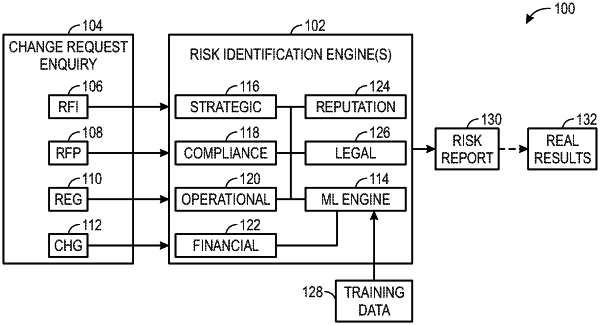| CPC G06Q 10/0635 (2013.01) [G06F 16/248 (2019.01); G06F 16/28 (2019.01); G06N 20/00 (2019.01)] | 20 Claims |

|
13. A computer-implemented method, comprising:
receiving first risk identification information from a first risk silo associated with a first subsystem of a system;
receiving second risk identification information from a second risk silo associated with a first subsystem of the system;
storing the first risk identification information and the second risk identification information in a risk aggregation data store;
receiving a change request indicating a potential change to the system, wherein the change request comprises a specialized computer parsable file comprising a tag structure, wherein the computer parsable file comprises tags that define conditions and corresponding computations associated with the system in response to the potential change;
identifying key words, phrases, or both from the change request by performing machine learning based upon the tags using a machine learning algorithm comprising a mathematical model configured to learn an objective function, wherein the mathematical model comprises input data and output data, wherein the objective function is configured to enable the machine learning algorithm to determine the output data for the input data that is not a part of training data used to train the mathematical model;
identify machine learning patterns indicating the potential change by performing the machine learning based upon the key words, phrases, or both;
identifying a risk associated with the change request, by performing the machine learning based upon the machine learning patterns, using the first risk identification information and the second risk identification information as the training data;
presenting the risk via an electronic risk report;
adding the risk to the risk aggregation data store configured to update the training data based on the risk;
iteratively optimizing the objective function based on the updated training data;
retraining the mathematical model to learn the iteratively optimized objective function based on the updated training data;
enabling the first risk silo and the second risk silo to cross-identify and report one or more new risks across the first subsystem and the second subsystem with improved accuracy based on the first risk identification information and the second risk identification information using the machine learning comprising the iteratively optimized objective function and retrained mathematical model;
receiving an electronic document from the system;
generating recommendations based on a risk compliance analysis using the machine learning based on the key words, phrases, or both, and the electronic document; and
generating a graphical markup of the electronic document based on the recommendations, wherein the electronic markup comprises an interactive graphic user interface configured to allow a user to modify the electronic document based on the recommendations.
|